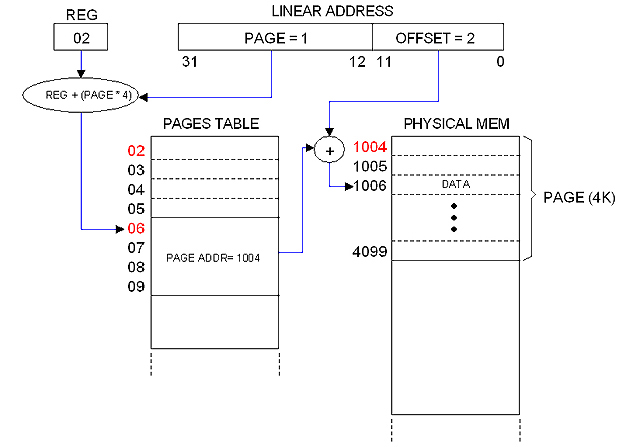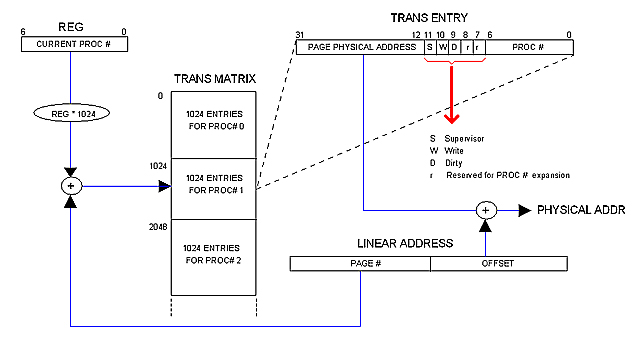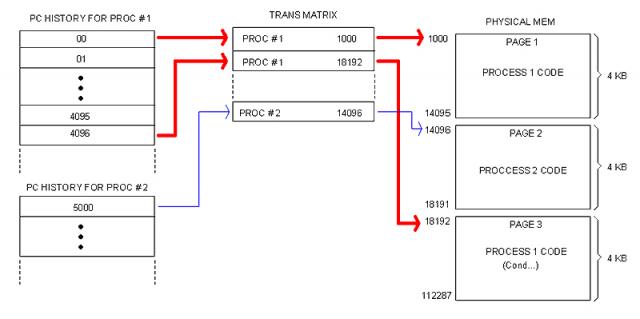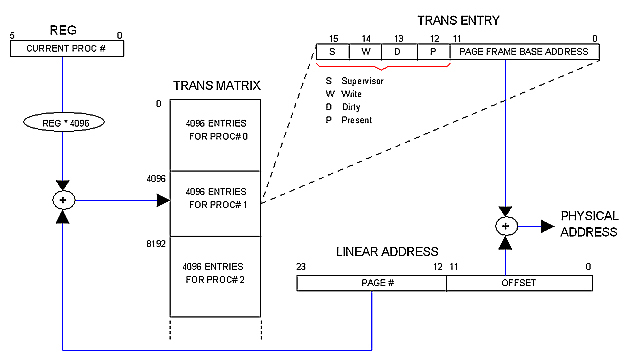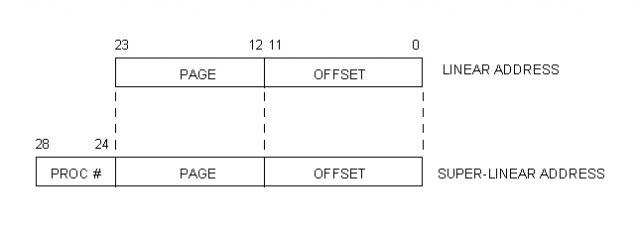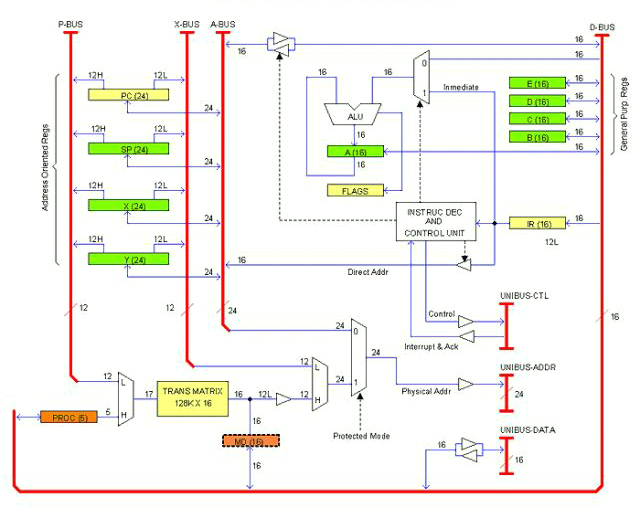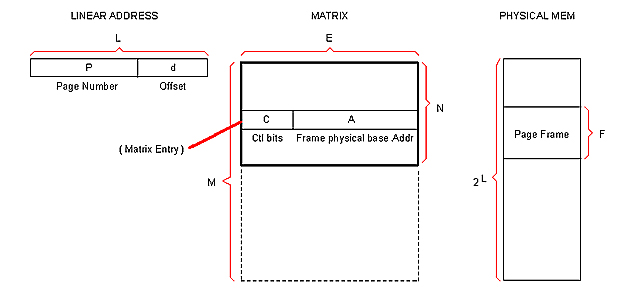Research NotesThese are the notes I made during the Research phase (May 2009).
Paging vs. Segmentation
05/21/2009
The title of this note is confusing; it suggests that Segmentation and Paging are mutually exclusive but that is not entirely correct. Those refer of alternate methods for managing virtual memory; however, modern processors such as Intel x86 provide support for both and is opt to the Operating System to use the one, the other or both.
Before entering into details, lets state that there are two ways (or "models") of seeing the virtual memory space: Linear and Segmented.
In the Linear Model, the virtual memory space is seen as an array of 2^32 (4G) bytes. To address it, a 32 bits pointer is all we need. The address provided this way is called a "Linear Address".
In the Segmented model the virtual memory space is divided into 2^16 segments, 2^32 bytes each. Two pointers are needed: One (16 bits) points to the segment; the other (32 bits) represents an off-set within the selected segment. This allows for a 2^(16+32) bytes (64 Terabytes). The address provided this way is called a "Logical Address".

|
We call this mechanism "Segmentation". A similar mechanism, "Paging", exists for organizing and managing memory in the Linear Model. Now lets get into details.
Since both models refer to virtual memory, some mechanism should exists to map virtual addresses into physical ones.
Segmentation (in the Segmented Model) maps the segment portion of the Logical Address to a physical memory address by the mean of tables called "descriptors". There can be a unique Global Descriptor Table (GDT), or one Local Descriptor Tables (LDT) per segment.
Paging (in the Linear Model) is performed by sub-dividing the 32 bits Linear Address into three fields called: Directory (10 bits), Table (10 bits) and Offset (12 bits), as shown below.
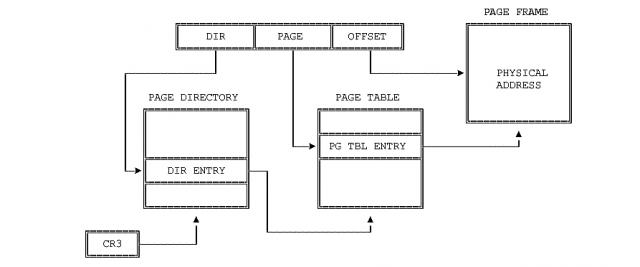
|
Two translation tables are employed for mapping the Linear address to a physical one: the "Page Directory" and the "Page Table". The Page Directory contains entries to the Page Table which in turn contains "a portion" of the physical addresses.
We said "a portion" because the physical memory is sub-divided into portions of 4K each called "Page Frames". The Page Table holds addresses for those page frames whereas the OFFSET portion (12 bits) of the Linear Address represents an off-set within the selected page frame.
Notice that as result of this paging schema we have up to 1024 directory entries each of which can contain 1024 pages, 4KBytes each, for a total of 4GB.
One may argue that the same job could be accomplished with just one table. The reason for the extra step is to handle the limited physical space with greater efficiency by making the size of the tables smaller.
When the two methods are used in combination, the Descriptor used by Segmentation does not hold physical memory addresses but Linear addresses which in turn get translated into physical addresses by Paging. In other words, each segment gets "paginated".
I have read that Linux prefers Paging to Segmentation because (1) it is simpler to implement and (2) because Linux is meant to be portable and some platforms such as RISC processors offer little support for segmentation.
The way for favoring Paging over Segmentation without losing the protection support offered by the processor trough Segmentation, is to use one segment only, then to implement Paging within that only segment.
More on Paging
The mission of Page Table entries is to describe Page Frames (not only to map them). Such description includes access rights, swap status etc. and it's used by the CPU to enforce general protection and to manage swapping, among other functions.
Each entry on a Page Directory (on a Page Table as well) consists of an array of 32 bits cconforming bit-mapped fields. We are not going to get into details but only to underwrite the following:
-- Each Page Table entry occupies 4 Bytes (32 bits). However, it describes a physical memory space of 4KB (one Page Frame).
-- Each Page Table occupies up to 4KB (1024 entries, 4 Bytes each).
-- Each Directory occupies up to 4KB too. In combination to the Page Tables it points, the Directory describes up to 1M page frames, that is, the entire 4GB linear address space as expected.
-- Page Directories and Page Tables hold the necessary information needed for the CPU to enforce protection.
An option for system designers is to allocate one global directory for each process running in the system. There are other options as well.
Learning from the PDP-11
05/31/2009
In this note I will mention those features of the PDP-11 that I am considering for adoption in my design.
Addressing words, no bytes
Unlike today's Intel microprocessors, in the PDP-11, addresses referred to 16-bits words, no 8-bits bytes.
Modularity
As most mainframe computers and minicomputers of the time, the PDP-11 consisted of separate units, but "Modularity" does not refers to this simple fact but instead to the way those units are interconnected in a flexible manner to allow for different possible configurations.
In the case of the PDP-11, modularity relayed on the UNIBUS.
UNIBUS
UNIBUS is a 56-lines path interconnecting all units together. It include Address lines (A0-A17), Data path (D0-D15), interrupt request lines (BR4-BR7), bus grant (BG4-BG7), Direct Access Memory (NPR), control and others.
Units use the UNIBUS to share information in a Master/Slave fashion. At any given time only one unit is in control of the bus (master) whereas other is serving as the slave. For example: the CPU as master and Disk drive as slave, or Disk drive as master and core memory as slave.
Bus access is negotiated between units by using Bus Request (BR) and Bus Grant (BG) lines according to a priority scheme.
Interrupts
Interrupts are organized into eight priority levels. The three lowest priorities are reserved to the CPU but this can be set (by software) to a highest one.
UNIBUS lines BR4-BR7 are used by devices for requesting bus control (interrupt). Devices connected to BR7 have the highest priority and so on.
Bus grant lines (BG4-BG7) are connected in daisy-chain. When the CPU grants bus control as result of a BR request, the associated BG signal is propagated from device to device along the chain. That device who issued the interrupt cuts the chain so the grant signal can not be propagated further.
Then, the device takes to bus and puts a memory address to it; that address is where the interrupt service routine resides. What the CPU does in response is just to load the Program Counter (PC) with that address to initiate a fetch bus cycle.
The CPU only serve interrupts which priority is greater that the one it has. For example, if the CPU has been set to priority 7, no interrupt will be served.
Interrupts can be nested, observing the priority scheme described above.
First Approach to Implementation
Simplified Memory Management
05/23/2009
The justification to simplify existing Memory Management techniques is that I want to explore those concepts in a manageable way so not get lost with complicated details. After all, it is not my intention to produce a commercial computer.
 Physical Memory Physical Memory
Physical memory is wired in 32 bits rows meaning that the data bus is 32 bits wide.
However, physical addresses refer to 8 bits chunks. For example, the address range: 0x01 - 0x10, represents a zone of 16 bytes, not 64 bytes. This is done by making the address bus from A31 to A2 as in the Pentium processors. Unlike Pentium, however, I will not allow bus cycles to get 8 nor 16 bits; instead, all bus cycles will always read or write a 32 bits row (four bytes at once).
This arrangement dictates (or suggest) other decisions such as: Instruction code must be 32 bits, CPU registers must be 32 bits though "splitable" into 16 and 8 bits so different data types can be available to the programmer, etc.
 Linear Model Linear Model
Applications will see memory as a Linear space of 2^32 bytes (4GB). As for physical memory, each increment in the Linear address represents one byte, not one 32 bits row. For example, for getting 8 contiguous bytes, the application may issue the following linear addresses: 0x01, 0x05 (not 0x01, 0x02).
Application code will be linked to produce linear addresses. Often, same addresses will appear repeated among different applications running simultaneously at a given time. For the CPU, however, application addresses represent nothing but offsets (indexes) within the designated space which only translate to physical addresses at the very bus-cycle time (by hardware).
Each application will believe that it owns the entire 4GB linear space. This illusion will connect to reality at translation time into the CPU circuitry.
 Paging Paging
The image below illustrates my simplified paging mechanism which mission is to implement linear-to-physical Address Translation and Global Protection.
The linear address is broken into two fields: PAGE (20 bits) and OFFSET (12 bits). This allows for 2^20 pages, 4KB each.
Pages are described in the PAGE TABLE. Each entry in the table takes 4 bytes representing bit-mapped fields. One of these fields (20 bits long) is the "Page Address" which is the base physical address for the referred page. The other fields are used for Protection.
The PAGES TABLE entry is obtained from the PAGE field of the Linear Address and a certain register (REG) which hold the base address for the Table. The PAGE field actually represents an index.
The OFFSET field of the Linear Address provides the index within the given physical page to compute the translated physical address, as illustrated in the diagram.
 One Pages Table for each running process One Pages Table for each running process
Since, as mentioned, each process believes to own the entire linear address space, one Pages Table for each process is needed. I will cover this in a separate note dedicated to Processes.
 The 4MB frontier The 4MB frontier
The Pages Table can be as small as 4 bytes or as big as 4MB. However, its natural size is 4KB (one page frame) because that is the granularity of memory allocation.
A Pages Table of 4KB has 1024 entries which describes 1024 pages, that is, 4MB of physical memory. Hence 4MB becomes a "natural frontier" for physical memory.
Therefore, it sounds natural to establish that the machine's memory will be expandable in steps of 4MB. Besides, 4MB of static RAM is about $100 at today's prices... definitely a reasonable frontier!
 Limitation of my one-step paging mechanism Limitation of my one-step paging mechanism
The Pages Table occupies a contiguous space in physical memory. It can expand to a maximum of 4 MB (2^20 entries times 4 bytes) but in practice it will be shorter since entries will be added as memory gets allocated.
This design imposes a limitation to the size of the Linear space: It cannot be greater that the greater physical address available. Otherwise, I will be forced to popultate the entire 4MB table to accomodate all possible linear addresses.
The system can still commit more memory than the physical memory available. What it cannot is to commit a Linear address for which an entry in the Pages Table does not exist.
That is the price to pay for my simplified one-step paging mechanism.
First approach to Paging implementation
05/23/2009
In previous note (Simplified Memory Management) I suggested that Pages Tables will take room from physical memory address space, but that is not true.
-- NOTE: --
I've borrowed most of the terminology from Intel literature but that "Pages Table" sounds ugly to me... I will call it "Translation Table" from now on, or simply "Trans Table".
-----------
I mentioned that it should be one separate Trans Table for each running process (since each process should be into believe that it owns the entire linear space). If I content my self to limit the number of simultaneous processes to a practical value, then I can afford to build a separate "room" in the CPU, out of the addressable RAM, to host all Trans Tables ever needed.
Let set the limits:
-- Max number of simultaneous processes: 128
-- Max RAM size: (Conceptually: 4 GB) expandable in steps of 4BM.
The "room" will be a SRAM matrix of 128K x 32 (using four 128K x 8 chips) expandable in steps of 128K x 32 (four chips). I will call this: the "Trans Matrix" or simply "Matrix".
Each row in the Matrix represents a Trans Table entry. With 4MB of RAM in the computer (1024 pages), 1K rows covers the entire linear space for that amount of physical memory. Therefore, with 128K rows at my disposal I can give one entire Trans Table to each of the 128 allowed processes.
As mentioned, expansion is possible (and easy). The only thing is that, as RAM expands, the Trans Matrix must be expanded accordingly. It would be better, maybe, to place the Matrix on the memory card, disributed among them in case that more than one exist.
System software is responsible for populating the Matrix. I will create the appropriate Supervisor instructions for doing that. Please notice that the Matrix needs to be updated as processes get alive and die, not only at boot up time.
 Close up to the Trans Matrix Close up to the Trans Matrix
05/23/2009
The following diagram illustrates how the Trans Matrix participates in address translation and protection.
The Matrix holds a record (1024 rows deep) for each running process. Each record constitutes the process Trans Table, that is, the space available for the process to allocate the 1024 possible Trans entries.
Each process has a process number (PROC #). The current proc # is kept in certain register (REG in the diagram) as long as the process is running. That number is used as an index to access the corresponding record. The PAGE field of the Linear address is used, in turn, as an index within the record to locate the exact Trans Table entry.
As mentioned in previous notes, the Trans Entry contains the physical base address for the page in physical memory. It also contains the following control fields:
S Set if the page is for Supervisor use only
W Set if writing on this page is permitted
D Set is the page have been modified
r Reserved for future expansion
PROC # Process number
There is a reason for including the PROC #.
I mentioned in a previous note (Limitation of my one-step paging mechanism) that the Linear space available to applications is limited far below 2^32. If a buggy code submits a linear address that exceeds the limit, chances are for the Address Translation mechanism to compute an entry that is valid but belongs to the wrong process. To avoid this, the CPU will always verify that the PROC # field matches the content of REG before proceeding with Address Translation. Besides, stamping each process page with the Proc# seems to me an elegant way of assuring that inter-processes interferience will not occur.
 Scalability Issue Scalability Issue
05/25/2009
I've being thinking all the time of a static and moderate (16MB at the most) main memory distributed among different cards, 4MB each.
Lets say, however, that one day I decide to build a card with 8MB instead of 4BM. In such a case, I'll dimension the Trans Table chuck accordingly (just for that card), hence the advantage of a distributed Trans Matrix.
Problem starts when memory increases far beyond "moderation". Imagine that one day I decide to play with dynamic memory and to build a card with 256 MB of dynamic RAM. The Trans Matrix chuck for that amount of memory becomes 8M x 32, that is: 32 MB of static RAM! (about $900 at today's prices).
There are several ways for working this issue out:
1.- Reducing the limit for running processes (currently 128).
2.- Not event thinking about large amount of memory.
3.- Discarding the solution all together.
First approach to Memory Allocation
05/24/2009
 Linear and Physical domains Linear and Physical domains
When we express memory addresses as Linear (0 to 2^32 -1) we say them to be in the "Linear Domain". Addresses expressed as physical (as wired in the circuit) are said to be in the "Physical Domain".
Since Linear-to-Physical address translation is done as part of the bus cycle (using the Trans Matrix), the physical domain is mostly restricted to that low level context. General purpose registers and even the PC (Program Counter) manage Linear Addresses instead of Physical ones. We can say that "our CPU works in the Linear Domain".
Memory allocation, however, is done in the Physical Domain since it involves Trans Matrix population and efficient ways of using the available physical memory, as we shall see.
 Memory Allocation Memory Allocation
The unit of memory allocation is the Page Frame (4KB of contiguous bytes in physical memory). For the CPU, an alloc operation involves not much but adding entries to the Trans Matrix. Once in the Matrix, referred pages can be accessed throughout the Paging mechanism at the CPU circuit level as part of the ordinary bus cycles.
The CPU must provide a supervisor instruction similar to this:
mem_alloc page, control
Where:
Page Physical address of the Page Frame
Control Bitmapped control fields and PROC #.
System software is responsible for keeping track of allocation. This involves (among others):
-- Distribution of physical memory among different processes (Effort must be made to avoid collisions).
-- Finding the correct physical blocks size for efficient use of memory.
-- De-allocation
 Contiguousness in Linear and Physical domains Contiguousness in Linear and Physical domains
We have to distinguish between contiguous Linear address and contiguous Physical addresses. A code segment without branches, for instance, always occupies a contiguous block in the Linear domain but not necessarily in the Physical domain as illustrated in the following image.
This will possibly be a common scenario in real life. Notice that memory fragmentation is hidden to the program code (which is in Linear domain), meaning that System software working with these issues must work in the Physical domain instead. Hence the need for Physical-Domain instructions provided by the CPU.
 Allocating Processes Allocating Processes
When a process is loaded, memory is allocated to store the code and leave room for the process data. Since I am not providing support for a segmented model, both code and data will share a monolithic block in Linear space.
The upper portion (lowest addresses) contains the code; the data block follows and extends all the way down to the bottom of the designated space.
At loading time the Data block is only the space remaining in the last page occupied by the code. The process code is responsible for requesting memory to the OS is needed. The OS will allocate requested memory as contiguous as possible just below. This way, the space designated to the process will grow indefinitely only limited by the amount of physical memory available at allocation time.
The way processes utilize their data space is opt to the language Compiler. The OS and/or the CPU can help with support for different techniques (stack, heap, etc) but they won't dictate the way programming languages manage their data.
 Linear Relative Address (RLA) and Program Counter (PC) Linear Relative Address (RLA) and Program Counter (PC)
We have established that applications believe they own the entire Linear space. Such a believe is more than an illusion: actually, there is no other Linear space but that given to the application at run-time. We can see the Linear space as being "multi-dimensional": The Trans Matrix contains all its "dimensions": one for each application running at a given time.
It follows that applications supply only Linear addresses and those are not absolute but relative to the beginning of the designated block in memory. In other words, the CPU interprets addresses supplied by the application as offsets within the designated code-data block. We call this a "Relative Linear Address" (RLA).
Application code is linked to produce RLAs. The first RLA (where execution starts) is always cero. The address where the Data block starts (following the Code block) is known at Link-Time, so addresses for instructions such as "MOV A, ADDR" can be resolved by the Linker and they are also given as RLAs (relative to the beginning of the Code block).
This has implications to the Program Counter (PC).
Fetch bus cycles will perform address translation from a given a Linear address. But we just said that application code always starts in address cero. Since (at application run-time) there is no Linear space other than the one owned by the application, then the RLA becomes the actual address to be fetched. Therefore, the content of PC can't be other but the RLA provided by the application code.
When paging is enabled (that is, when not in Kernel mode) there is no need for a CS register. No need for a DS register either. I can still provide support for stacks (a SP reg and associated PUSH/POP instructions, for example) but that will be a plus, not strictly required by the conceptual model.
Second approach to implementation
05/26/2009
In this second try, I'm bassically scalling down the first to manageable values.
Critics to my first approach
My "First approach to implementation" failed to meet expectations. Here is why.
 32 bits architecture 32 bits architecture
There is no need for a 32 bits architecture. The aim of 32 bits address space with 32 bits data path was only in to leave enough room for further development. However, the figures ran close to unfeasibility so I've decided to restrict the architecture down to reality. After all, it is not my plan to compete with my PC but just to create a hardware environment to play with.
 The all-for-one commitment policy with 32 bits The all-for-one commitment policy with 32 bits
I have adhered to this principle from the very beginning. It stated that every application running in protected mode must believe it owns the entire Linear address space, that is all memory in the system (and yet that not physically present) up to 4GB (2^32).
I still consider it's a good idea. Problem is that 32 bits are too many bits. That, combined with the multi-dimensional Trans Matrix, ran out of reality big time.
 Code and Data in monolithic block Code and Data in monolithic block
Putting code and data together in same block under the application's control makes it difficult to share process's images among different users.
In a multi-user environment same process should be able to run on behalf of different users at the same time, so the process's code must be shared among them but the data must not. It follows that it's better to keep code and data in separate areas perfectly distinguishable by the Operating System for easier manipulation.
Brief description of the "new machine"
Here is how the machine starts to looks like:
Data Bus : 16 bits
Address Buss : 24 bits
Main Memory : SRAM up to 16 MB
Virtual Linear Space : From 0 to 2^24 - 1
Paging mechanism : 128Kx16 SRAM Translation Matrix not in Addr Space.
Max symultaneous processes : 32
 All-for-One Policy All-for-One Policy
As stated before, the System commits all Linear address space to each application running at a given time. User applications are linked to produce Linear Addresses relative to the beginning of the designated code block, starting with address cero. Maximun address is 2^24 - 1.
 Linear Address and Paging Linear Address and Paging
A Linear address is 24 bits wide. It is broken into two 12 bits fields: PAGE and OFFSET.
Physical memory is broken into 4 KB blocks of contiguous addresses called "Page Frames". The page frame constitutes the memory allocation unit.
Each page frame is described (and translated) by the corresponding entry (or "Frame") in the Trans Table, as illustrated bellow.
Each process processes its own Trans Table. System Software (OS) is responsible for keeping them updated at boot-up and run-time.
 Multi-dimensional Trans Matrix Multi-dimensional Trans Matrix
Trans Tables are not in Main memory but in a separate circuit called "Trans Matrix" (or simply "Matrix") which is 16 bits wide and 128K rows deep regardless the amount of physical memory installed in the machine.
The Matrix is said to be "multi-dimensional" because it contains the Trans Tables for all 32 allowed processes. This way, each process runs in its own "dimension" of the Linear space. The OS distributes physical memory among processes dynamically by filling in the Matrix.
The following diagram illustrates how it works.
( + ) and (REG * 4096) circles are shown for illustrative purposes only. In practice REG will simply contribute the most significant bits to the Matrix row decoder whereas the PAGE field of the Linear address will contribute the least significant ones. Same for: PAGE FRAME BASE ADDRESS + OFFSET = PHYSICAL ADDRESS.
 Super-Linear space Super-Linear space
Unlike user processes, that always work in Linear space (within its own "dimension"), Kernel code needs access to all processes memory meaning that it needs access to the whole Trans Matrix.
With this purpose, we define a "Super-Linear Space" that ranges from cero to the size of the Trans Matrix times the size of a page frame.
Using the limits we have established, the size of the Super-Linear Space can be calculated like this:
SL_Size = (Page_Frame) (Trans_Table_Entries_per_Process) (Max_Processes)
= (4KB) (4096) (32)
= (2^12) (2^12) (2^5)
= 2^29
= 512 M
The following diagram illustrates the relationship between Linear and Super-Linear address.
Paging in Kernel mode
05/27/2009
Since Trans Tables are not in Main memory, there is no need for defeating Paging when Kernel code is running. Moreover, keeping Paging active brings advantages to the Kernel's job.
Let's assume that the Trans Matrix has been pre-initiated by some pre-Kernel software possibly hold in ROM chips. This initiation regards only the first Trans Table: that of the Kernel. Yes, Kernel code resides in virtual space so it suffers address translation as everyone else. Kernel is nothing but "Process #0".
There is something special about this Kernel area, however: The CPU is designed so all interrupts are serviced from Trans Table #0, that is Process #0 which is the Kernel.
This has implications to System Calls.
When a process needs Kernel attention, it raises INT 80 (the number 80 is just an example, matching Linux in this case). Call arguments are passed in CPU registers, as expected.
In some cases, arguments represent pointers to memory (a buffer, a stru file descriptor, etc). The question is what kind of "memory address" does this pointer represent: a Physical address or a Linear Address?
We have established that processes only deal with Linear addresses so that is the only kind of address it can pass in a System Call. The Kernel code would then have to make a translation (to physical address) based on information it holds about the calling process.
With Paging enabled, the translation is almost automatic.
Say for instance that the calling process has passed a buffer's address where it wants data to be placed. This will be a Linear address pointing (relative) to somewhere within the process's data block. Let's call it LOCAL_BUFF.
In order to know where to serve the requested data, the Kernel needs to compute a "Super Linear Address" which translation matches the physical address of LOCAL_BUFF. Let's call it BUFF and calculate it like this:
BUFF = (PROC# * 4096) + LOCAL_BUFF
Now, by simply addressing the Matrix with BUFF, the exact Physical address is automatically obtained. In other words, the user's buffer has been addressed via ordinary bus cycle with Paging enabled.
We see that "Kernel mode" is not a strong concept any more; Kernel pages are marked as Supervisor which allows access to special CPU instructions, that's all. We see also that Paging does not need to be enabled or disabled; all buss cycles can be done in the same way by using the Matrix.
One may argue that the Kernel will need to fill in the Matrix any ways with physical addresses so it must be able to work in the Physical domain. One answer may be that the Matrix is only accessible through special supervisor instructions since it is not in addressable space; thus Kernel code could manage to know the Physical memory without having to actually address it; as a matter of fact the Matrix maps the Physical Memory in some way.
I can't have this as a final conclusion, however. For one part, that is not the way real-life Kernels and processors work; for the other, I haven't explored all of the consequences with full detail. Moreover, being this an "experimental" computer, it is better for me to have as many choices as possible, as for instance the ability to enable/disable the Paging mechanism.
 Addressing the Matrix Addressing the Matrix
05/28/2009
I were thinking of a set of privileged instructions as the only way to access the Matrix. But now it occurred to me that a more open (so powerful) mean would be to allow Kernel code to simply address the Matrix.
Of course, Kernel code will be doing so in Super-Linear space. However, only the most significant 17 bits of the (29 bits) Super-Linear address are needed since the other 12 represent the off-set within the page frame (as in Matrix entries). The following diagram illustrates the idea.
Register MD is not a real one but a fictitious resource provided by the CPU to facilitate Matrix Read/Write operations as in (for example):
MOVI MD, value
CPU the first Sketch
05/29/2009
The following drawing is an early sketch (actually the first) of the CPU architecture or block diagram, whatever you want to call it.
This is supposed to be a single PCB card. As per today I don't know if the computer will take one or more units (enclosures); several cards, for sure. The idea is that all cards (and/or units) will be plugged to a common bus that I have called UNIBUS (as that of the legendary PDP-11, not sure if I'm going to adopt exactly that bus).
The UNIBUS consist of Data lines (16), Address lines (24) and Control lines including IRQs. In the drawing they are termed: UNIBUS-DATA, UNIBUS-ADDR and UNIBUS-CTL respectively. This is the way out for the unit (or Card).
There are also internal buses. Those are: D-BUS (16 bits Data), A-BUS (24 bits Address), X-BUS (12 bits Offset) and P-BUS (12 bits Page). These buses communicate registers and other resources inside the CPU card.
Registers can be classified into three categories:
- General Purpose: A, B, C, D, E
- Address Oriented: PC, SP, X, Y
- CPU specific: IR, FLAGS, PROC, MD
There is also the Trans Matrix.
General Purpose registers are 16 bits and they are accessible to the applications programmer. The Accumulator (A) serves as left operand and result holder for the ALU (as in must real-life processors).
Address Oriented registers are 24 bits. They have bidirectional access to the A-BUS and split one-way access to the P-BUS and the X-BUS. In the drawing, each line is marked with the number of bits it carries; when split, an H or L suffix added to the number indicates whether it is the Most or Least significant half.
CPU specific registers have different sizes. IR (16 bits) is the Instruction register; FLAGS is the Status register. When the CPU is in Protected mode, the register PROC (5 bits) indicates the current process number. MD is a fictitious register that represents the current Matrix entry.
The Matrix is a SRAM arrangement of 128K rows by 16 bits. It is addressed by the combination (multiplex) of PROC and the P-BUS. The 12 least significant bits of the selected row represents the physical base address of the Page Frame to be addressed in the current bus cycle. By multiplexing this output with X-BUS (which contributes the Offset) the whole 24 physical address is obtained. If the CPU is in Protected mode, that address is taken to UNIBUS-ADDR; otherwise, the A-BUS content is taken instead.
In the drawing, registers are marked with different colors to highlight privileged use. Green registers are accessible to the Applications programmer. Orange registers are only accessible to System programmers (that is, if the CPU is in Protected mode, code cannot access these registers if it is not in page frames flagged as "Supervisor"). Yellow registers are indirectly accessible throughout instructions; for example, a jump instructions overwrites the Program Counter. When the CPU is in Real mode, page priviledges are not checked so orange registers are accessible to all code.
Note that register PROC is for System programmers use. That is the way for Kernel code to work in Super-Linear space (I'm keeping my idea of the Kernel working in Protected mode but this may change).
Some implementation details are not clearly illustrated in the drawing as for example the rules for transferring data between registers of different sizes. There is a number of different ways of doing that but I'm not going to work it out at this time.
Calculating the Matrix
The size (thus the cost) of the Matrix has proven to be a critical concern. Lets imagine a generic Matrix so we can adjust values until acceptable results are obtained.
These are the variables:
L : Size of the Linear addressable space.
P : Size of the PAGE field in the Linear address.
d : Size of the OFFSET field in the Linear address.
F : Number of addresses composing a Page Frame in physical memory
E : Size of a Matrix entry.
A : Size of the FRAME_ADDRESS field in the Matrix entry.
N : Number of Matrix entries per Table (that is, per process).
S : Number of max simultaneous processes.
M : Total number of Matrix entries (for S processes).
Note: Sizes are in bits.
Here are the relationships between those variables:
d = log2 (F) ; Number of bits needed to address F
P = L - d ; A linear address has L bits
A = P ; This conclusion is easy to obtain
N = 2^P ; The Trans Table has as many entries as P can address
M = N * S : The Matrix has as many tables as allowed sim. processes.
 Procedure Procedure
We start by fixing the size of the Linear space (L) since that will determine the max amount of physical memory allowed in the system.
Then we fix the size of the page frames (F). Here is a trade-off situation: The smaller is F, the bigger becomes the Matrix; but making F too big will degrade memory management efficiency. We can start with a reasonable value (say, 4KB).
With these two variable fixed, we can start doing the math
#Linear Address fields:
d = log2 (F) ; Number of bits in the OFF_SET field
P = L - d ; Number of bits in the PAGE field
#Matrix entry:
A = P ; Number of bits in the FRAME_ADDRESS field.
The Matrix entry also has control bits (about 4) and can also contain reserved bits. What we do is to add them all, then we round to a multiple of 4 (for practical reasons). Extra bits resulting of rounding will be considered "reserved".
#Trans Table size:
Trans Table is the chunk of Matrix dedicated to one process. The number of entries is:
N = 2^P
So far we have a Matrix that is N rows by A bits... per process.
#Matrix size:
The Matrix has as many trans tables as simultaneous processes are allowed (S). This is another trade-off situation. In this step we fix S seeking a comfortable value with acceptable cost in Matrix RAM.
M = N * S
The final size of the Matrix is M rows by A bits.
 Example Example
Let Main Memory be 2MB as the most. Therefore L = 21.
With such a small memory lets keep granularity high, say 1 KB per frame, that is: F = 1024.
#Linear Address fields:
d = log2 (F) = 10
P = L - d = 21 - 10 = 11
#Matrix entry:
A = P = 11
We have 4 control bits so the entry would be: 11 + 4 = 15 bits. Since this is kind of odd, we round to 16 bits and tell programmers we have let a "reserved bit", which sounds very technical.
#Trans Table size:
N = 2^P = 2048
So we have 2K x 16 bits (4KB) per process.
#Matrix size:
Let say we want to allow up to 128 simultaneous processes.
M = N * S = 2048 * 128 = 262,144
That is 256 Kwords (512 KB).
If we can afford to build this Matrix, then our system can be described as following:
- Main memory : 2 MB max
- Sim. Processes : 128 max
- Matrix size : 256K x 16 bits (512 KB).
(not too bad...)
Third Approach to Implementation
05/31/2009
This approach derives from my Second Approach to Implementation, now narrowed to more definite values. In addition, a promising interrupt scheme has been introduced.
Features
Data Bus : 16 bits
Address Bus : 20 bits (address refers to 16 bit words)
Main Memory : SRAM 1 Mw (2 MB) max.
Operating Modes : Step, Real, Protected
Protection Method : Paging via (not mapped) Multidimensional Matrix (16K x 16)
Multitasking : Up to 16 processes running on separate time-slices.
Peripherals : Memory mapped
Interrupts : Vectored 256 max.
Nested ISR : Yes, based on priority.
Interrupts
Interrupts are organized into 256 vectors termed INT_00 through INT_FF. The first sixteen ones (INT_00 through INT_0F) are for CPU internal use; all others (INT_10 to INT_FF) are available to peripherals. Vectors point to memory addresses in the very first block of the addressable space taking two consecutive addresses per vector as we shall see.
Nested interrupt service is allowed according to vector priority. INT_00 has the highest priority whereas INT_FF has the lowest.
 Hardware Hardware
The external bus (E-BUS) provides two lines for managing interrupts: IRQT and IACK.
Devices request CPU attention by activating the IRQT line. The CPU grants the bus to the requester device by activating the IACK line. This line is connected in daisy-chain from device to device. Devices that have not made the request pass the signal down to the chain; the device who made the request disconnects itself from the chain so the acknowledge signal can not propagate further.
Once the requester device is in control of the E-BUS, it puts its interrupt vector on the Data lines and drops the IRQT signal. This vector have probably been set by DIP switches into the device at installation time.
When the CPU senses the IRQT dropped (with IACK still active), it reads the vector from the E-BUS, drops the IACK signal and calls the appropriate interrupt service routine (ISR).
 Software Software
Interrupt vectors points to consecutive locations in the very first block of the addressable space. Each vector takes two consecutive addresses; thus INT_00 points to 0x00000, INT_01 points to 0x00002 and so on. INT_FF points to 0x001fe.
For servicing an interrupt, the CPU will do nothing but a fetch bus cycle toward the corresponding address. What is expected to be there is a branch instruction to the actual ISR.
INT_00 is the computer's clock tick, raised at 1 ms intervals. A multitasking operating system can make use of INT_0 to define processes (or threads) time-slices.
INT_01 through INT_FF are used by the CPU to generate exceptions. Software code is allowed to raise interrupts within this range by using the INT instruction.
All interrupts are maskable. Not masked interrupts can be served in a nested fashion according to interrupt priority.
Queuing interrupt requests is the job of the Operating System. The CPU limits itself to service interrupts in the simple way we just described.
External Bus (E-BUS)
All units connect to the External Bus (E-BUS) which is made of two multi-pair cables (termed A and B) ended with D-SUB 25 pins connectors at both edges. A and B cables interconnect units in daisy chain topology.
These are the signals present in each cable. The actual pinout has not been defined yet.
CONNECTOR A
=====================================================
A00-A19 Address lines
GND Signal Ground
CONNECTOR B
=====================================================
D0-D15 Data path
IRQT Interrupt Request
IACK Interrupt Acknowledge
DMAR Direct Access Memory Request
DMAK Direct Access Memory Acknowledge
BBSY Bus busy
DTWR Data Write
DTKE Data Take
GND Signal Ground
Power lines are not provided in the bus so units are required to be self-powered.
Signals DMAR and DMAK are similar to IRQT and IACK but they work with Data Access Memory (DMA) rather than interrupt.
Signal DWRT determines whether the bus cycle if for reading or writing (from the Master viewpoint). It is active for write cycles.
Signal DTKE will usually be connected to Output Enable pins (OE) of three-state chips. Actual data transfer occurs when this line is activated.
|




